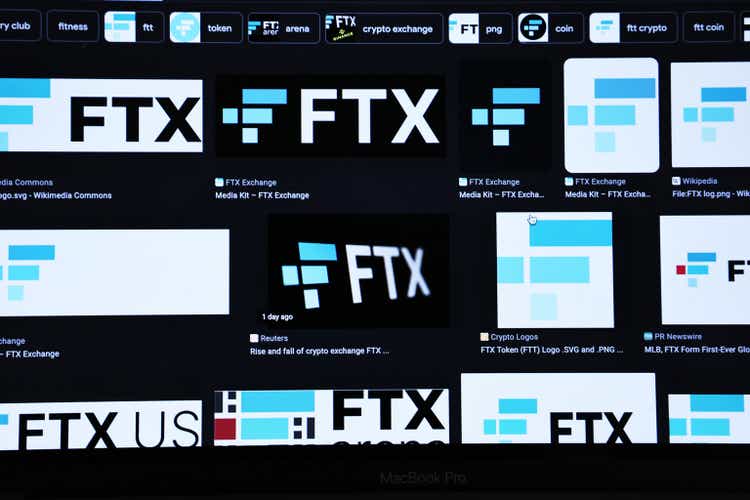Michael M. Santiago
By Mirva Anttila
What Happened with FTX
Rumors began circulating starting the week of November 1 that the balance sheet of Alameda Research, a quantitative trading firm and a sister company of FTX (FTT-USD), a Bahamas-based offshore crypto exchange, might be in trouble.
They both have the same owner, a 30-year-old crypto “golden boy,” Sam Bankman-Fried (widely known as “SBF”). It now appears FTX might have lent out customer funds and assets (no proof of this, though) to Alameda Research, which made risky bets with those assets.
This is strictly prohibited in traditional finance. Both companies are private, but the market estimates that 40% of the balance sheet of Alameda Research might comprise FTT tokens, utility tokens created by FTX, and these were used as collateral at the firm.
The CEO of Binance (BNB-USD), Changpeng Zhao, or CZ, got wind of this in the week of November 1 and said over the following weekend that Binance would sell all of its FTT tokens (worth more than $500 million). This created the cascade of events we are witnessing and a “bank run” on FTX.
On Tuesday, November 8, Binance and FTX agreed on a letter of intent whereby Binance might potentially purchase FTX Global (leaving FTX US intact), but after starting due diligence, Binance concluded that the finance gap at FTX is “too big” and withdrew the offer.
From the on-chain activity, the industry has recently observed money transfers from wallets at Alameda to FTX. It appears that Alameda lost money on its trades and cannot pay back the funds and assets borrowed from FTX. FTX has been reported to have a shortfall of at least $8 billion.
Current Situation
After Binance’s withdrawal of its offer to take over FTX, the question was, who would be big enough to fill the finance gap at FTX? In the traditional finance industry, the government might bail out the troubled company, but there is no government backstop in crypto. Coinbase (COIN) has ruled itself out.
After Binance, there were rumors that Tron (TRX-USD) cryptocurrency network’s Justin Sun was working with FTX to put together a $9.4 billion “solution.” Several investment funds and companies had access to FTX’s data room and were reviewing its books. Just a short while ago, on Friday (November 11), FTX filed for bankruptcy.
Reputation of SBF
Apart from the shadiness of potentially using client funds to make risky bets, there are questions about what the customers and investors of FTX actually knew or were told. Were they given full and honest information about what was going on?
FTX was valued at $32 billion in January, and blue-chip VCs had completed due diligence on the company. If it misled investors and clients, a court case could come for SBF.
It is understood that the Securities and Exchange Commission and the Commodity Futures Trading Commission are investigating whether FTX properly handled customer funds and its relationship with other parts of Bankman-Fried’s crypto empire, including his trading house Alameda Research. It is also understood that officials from the Justice Department are working with SEC attorneys.
What Changes Are Needed in the Industry
The allegations against FTX are that it lent out customer assets for risky activities. If this sounds familiar, it’s because it’s a move we have seen before in recent months with other bankruptcies. The FTX incident is amplified by its size, the characters involved, the alleged self-dealing and the, as of now, unclear legal implications.
Clearly, the business model of lending customer assets without their knowledge or understanding has real risks. At WisdomTree, we believe the published proof of reserves and due diligence of service providers, such as custodians, are important in this nascent space. Should customers want to earn yield by lending assets, this should be a conscious decision and known risk that they take.
Using utility tokens as collateral, particularly utility tokens created by a firm that is also accepting them as collateral, is highly risky, as they are vulnerable to short attacks. The other question is: how can you use “Monopoly money” you created yourself and claim it could be used as collateral and a replacement for real money?
Contagion Fears
Most cryptocurrency values have been down significantly in the past five days. Bitcoin (BTC-USD) is down 20%, Ethereum (ETH-USD) 24% and Solana (SOL-USD) 54%.
Solana is down more than others because Alameda Research was one of the early initial coin-offering investors in Solana in 2021, and Alameda is said to have held staked and unstaked Solana worth billions of USD.
We expect contagion to continue for days/weeks. Several investors have already written down the investment at FTX to zero. The most obvious companies to track are the lenders to Alameda Research, clients of FTX and other companies with direct or indirect exposures to FTX, Alameda Research or FTT tokens.
At this point, we do not have enough information to judge how much, if any, could be salvaged from the bankrupt FTX and its sister company Alameda Research.
Future of Crypto
We believe there is still great potential in crypto and, as anyone who follows us will know, blockchain more broadly. The early stages of most new technological developments are prone to problems, hiccups and setbacks; however, these recent issues have been business model and risk management failures as opposed to technological issues.
Blockchain or bitcoin didn’t “break.” The underlying technology generally performed as intended. Instead, the centralized platforms, some offshore and lightly regulated, precipitated the issues. Some fundamental changes at businesses are needed to make the industry more transparent and trustworthy with less dependence on a few players.

Mirva Anttila, Director, Digital Assets Research
Mirva joined WisdomTree’s Research team as a Director in August 2022 from a Senior Advisory role at a Swedish fund advisory firm. Prior to that, Mirva headed an Alternative Investments team at a Finnish asset manager FIM and spent over 15 years as a Senior Partner and Portfolio Manager at a New York-based family office focused on listed technology and growth stock investing, as well as alternative investments.
In addition, Mirva has over six years’ experience from the sell-side as Head of Telecom Equities team at Danske Securities and as Director at CIBC Capital Markets. Mirva started her career in strategic planning at Nokia. She holds a Master of Science degree in Economics from Aalto University, Finland’s leading business school.
Editor’s Note: The summary bullets for this article were chosen by Seeking Alpha editors.


Be the first to comment